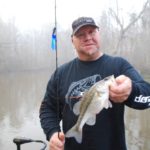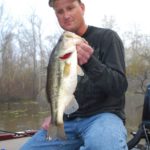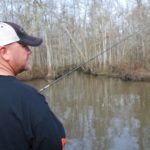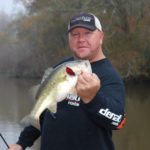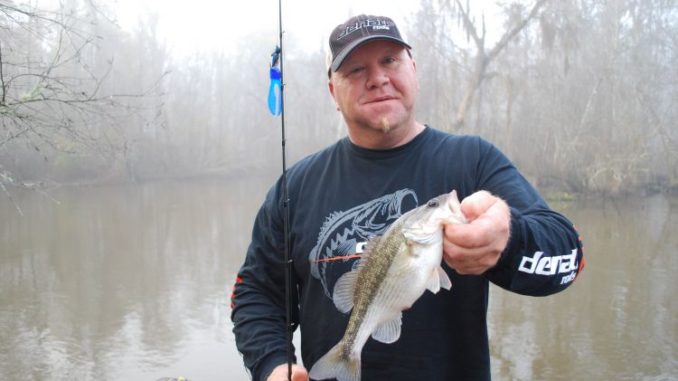
A massive paper mill discharge wiped out the fishing on the Pearl River in 2011, but this picturesque maze of water has recovered. In fact, the bass fishing is probably better than it’s ever been. Here’s how to capitalize.
When we pulled up to the rugged little launch off to the side and under the Highway 90 bridge over the Middle Pearl River, Chance Morse got out of the truck and strode closer to the water’s edge.
The big guy squinched one eye at the bridge.
“The bell’s sticking out of the water,” he declared. “With the tide we have, something’s going to happen.”
It was sweet to hear those positive words before the boat even hit the water.
The bell Morse was talking about was simply a concrete ring around the bridge’s pylons. It was his indicator of action.
With Morse was Jeff “Beak” Jacob, a co-worker at Denka Performance Elastomer and his regular bass tournament fishing partner. They average fishing in 20 two-day bass tournaments a year, each one demanding additional pre-fishing days on the water.
And they still find time for “pleasure trips” (their words) like this one.
It was a cool, damp and foggy morning — it was January, after all. I pulled my knitted cap down over my ears as Morse charged his chariot north in the river.
The flanking vegetation, dominated by roseau canes, quickly gave way to scattered trees and finally segued into a cypress-tupelo swamp.
Forty-four-year-old Chance Morse began fishing the Pearl when he was 19, and he still spends a lot of time on it.
“It has a lot of bass by number here,” he said. “You can catch 100 if conditions are right. I’m not saying they are all big fish; a lot are in the 1½- to 1¾-pound size range.”
Jacob, who grew up fishing the Reserve Canal, the Atchafalaya Basin and Caernarvon, began fishing the Pearl when he teamed up with Morse six or seven years ago.
Jacob gave me the first Pearl River fishing lesson of the day, explaining they would be concentrating on the mouths of small watercourses (Morse called them “drains,” while Jacob called them “sloughs”) where they entered the river.
Both men threw ½-ounce blue Strike King Hack Attack jigs, although Morse allowed that black-and-blue or crawfish colors with a lot of orange also work well.
Each stuck a sapphire blue Zoom Ultra Vibe chunk on his jig.
They never changed lures all day, for the simple reason that the lures worked all day.
Right off the bat, still in the thick fog, Morse connected with a respectable spotted bass, followed quickly by a big-bellied 3-pound largemouth that jumped on Jacob’s jig.
Jacob’s fish had black blotches on its jaws, a condition called “melanosis” by biologists.
“That means that they are getting ready to spawn,” he said.
Morse agreed.
“Yeah, you see them common on bass from late January to early May,” he said.
The conditions seems to worsen throughout the spring.
“By (May), they will be all over the body,” Jacob sad.
Both anglers fished their jigs either with a slow bounce off the bottom or by slow-swimming away from the bank into deeper water.
“The fish will tell you what they want,” Morse said.
On this day, both methods seemed to work.
The boated fish regularly, largely due to not wasting time on unproductive stretches or bank between drains.
They pulled up to trolling motor distance of a drain, trolled closer and thoroughly probed it with repeated casts
Then they fished several boat lengths above and below the drain before cranking up and moving on.
Hotspots occurred when two or more drains were located trolling motor close to each other. No drain, no matter how small was left unexplored, however.
While they fished, Morse explained in fine detail how to plan successful Pearl River bassing trips.
“What I look at are river gauges — really only the one located at (the town of) Pearl River,” he explained. “This one is above any tidal influence (from Lake Borgne), so it gives me what the river is actually doing. Once it hits 10 feet or below on a natural fall, the fish are actively feeding in the drains, primarily on crawfish, so jigs are real effective.
“With anything above that level, the water is over the banks, and fishing is not good without exposed banks. When a falling river approaches 7 feet, the fish pull away from the banks and move into the deeper water of the river’s channels.
“But tides do affect much of the area that I fish. So, once the river gauge tells me it’s right, I go to LouisianaSportsman.com and pull up ‘Paris Road Bridge.’ What is happening at the Pearl is four hours behind that, time wise. I want to fish on a falling tide.”
For this trip, the Pearl River gauge was at 9.8 feet and the water was milky-green.
“When the river is muddy, it is usually when it is on a rise,” Morse said. “Even if the river gauge is at the right number, a rising river is tough fishing.”
When the river drops to 6 or 7 feet, it will become green-clear, again not the best of conditions for bass fishing, he said.
Until 9:30 a.m., the fishing had all been north of the Interstate 10 bridge crossing the river. But, in spite of catching almost two dozen fish, the pair got itchy feet and decided to shift downriver.
“Lots of times I don’t have to go below I-10, but they really aren’t biting well enough for me here now,” Morse explained. “I don’t want to go as far south as the roseau cane area. That’s more marsh fishing — finesse fishing.
“That’s not for me. I like jigs, wood, and current. Fishing is a lot more dependent down there on tide than on river current.”
Their new stops didn’t produce a single bite: The tide was beginning to play out.
Seeking current, Morse ran farther south in the Middle Pearl and then doubled back northward in the Middle West Pearl.
Friday’s Ditch, a big chute funneling water directly from the West Pearl into the Middle West Pearl, had plenty of current.
In fact, the water was really rolling.
“Even at dead low water, there is a strong current in Friday’s Ditch,” Morse explained. “I believe that there is probably a 4-foot elevation difference between the West Pearl and the rest of the system.”
After boating a few more bass, Morse and Jacob decided to devote the rest of the morning to a tour of the system for my benefit. If they were fishing for their ice chests, they would have already had to quit, anyway.
Morse ran back to the Middle Pearl River. From there, he took Morgan’s Slough and Carry’s Ditch to the East Pearl River, in which he headed north past the I-10 bridge.
At the first big fork after the bridge, he veered left into Wastehouse Bayou. The hardwood-lined bayou looked different than the other fishing stops, breaking up into multiple small bayous that petered out farther into the swamp during low river levels.
“You can troll way up in these and catch lots of fish,” Morse noted.
“They are deep, too,” Jacob added.
At high flow levels, Morse said, the West Pearl filters through low areas in the swamp to feed its waters into Wastehouse Bayou and then ultimately the East Pearl.
Unlike the other waterways, drains on both sides of Wastehouse Bayou will produce bass, although Morse admitted the ones on the west side of the bayou are better.
Finishing the grand tour, Morse piloted his bass boat from the East Pearl through Bayou Chalon and back to the Middle Pearl River.
It was a big swamp.
My head must have been visibly spinning, because Morse looked at me and grinned.
“Google Earth is really something useful to use in this area,” he said.
I couldn’t have agreed more.
